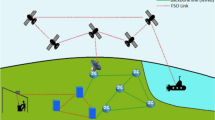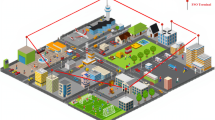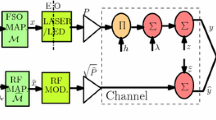Abstract
Nowadays, the smart grid has demonstrated a great ability to make life easier and more comfortable given recent advances. This paper studies the above issue from the perspective of two important and very useful smart grid applications, i.e., the advanced metering infrastructure and demand response using the instrumentality of a set of well-known scheduling algorithms, e.g., best-channel quality indicator, log rule, round robin, and exponential–proportional fairness to validate the performance. To increase the data transmission bandwidth, a new concept of optical wireless communication known as free-space optical communication (FSO) system based on microring resonator (MRR) with the ability to deliver up to gigabit (line of sight) transmission per second is proposed for the two studied smart grid applications. The range between 374.7 and 374.79 THz frequency band was chosen for the generation of 10 successive-carriers with a free spectral range of 8.87 GHz. The ten multi-carriers were produced through drop port of the MRR. The results show up to 10 times bandwidth improvement over the radius as large as 600 m and maintain receive power higher than the minimum threshold (− 20 dBm) at the controller/users, so the overall system is still able to detect the FSO signal and extract the original data without detection.









Similar content being viewed by others
References
Palensky, P., & Dietrich, D. (2011). Demand side management: Demand response, intelligent energy systems, and smart loads. IEEE Transactions on Industrial Informatics,7, 381–388.
Fang, X., Misra, S., Xue, G., & Yang, D. (2012). Smart grid—The new and improved power grid: A survey. IEEE Communications Surveys and Tutorials,14, 944–980.
Yan, Y., Qian, Y., Sharif, H., & Tipper, D. (2013). A survey on smart grid communication infrastructures: Motivations, requirements and challenges. IEEE Communications Surveys and Tutorials,15, 5–20.
Mohassel, R. R., Fung, A., Mohammadi, F., & Raahemifar, K. (2014). Application of advanced metering infrastructure in smart grids. In 2014 22nd mediterranean conference of control and automation (MED) (pp. 822–828).
DRMS, S. (2012). Demand response management system version 2.0. Siemens USA. Retrieve from http://w3.usa.siemens.com/smartgrid/us/en/demand-response/demand-response-management-system/Pages/Demand_Response_Management_system1019-6647.aspx#content.
Zhou, J., Hu, R. Q., & Qian, Y. (2012). Scalable distributed communication architectures to support advanced metering infrastructure in smart grid. IEEE Transactions on Parallel and Distributed Systems,23, 1632–1642.
Dinh, H. T., Lee, C., Niyato, D., & Wang, P. (2013). A survey of mobile cloud computing: Architecture, applications, and approaches. Wireless Communications and Mobile Computing,13, 1587–1611.
Guan, L., Ke, X., Song, M., & Song, J. (2012). A survey of research on mobile cloud computing. In 2011 10th IEEE/ACIS international conference on computer and information science (pp. 387–392).
Fan, Z., Kulkarni, P., Gormus, S., Efthymiou, C., Kalogridis, G., Sooriyabandara, M., et al. (2013). Smart grid communications: Overview of research challenges, solutions, and standardization activities. IEEE Communications Surveys and Tutorials,15, 21–38.
Saxena, N., & Roy, A. (2015). Exploiting multicast in LTE networks for smart grids demand response. In 2015 IEEE international conference on communications (ICC) (pp. 3155–3160).
Fadel, E., Gungor, V., Nassef, L., Akkari, N., Maik, M. A., Almasri, S., et al. (2015). A survey on wireless sensor networks for smart grid. Computer Communications,71, 22–23.
Colak, I., Sagiroglu, S., Fulli, G., Yesilbudak, M., & Covrig, C.-F. (2016). A survey on the critical issues in smart grid technologies. Renewable and Sustainable Energy Reviews,54, 396–405.
Medina, C., & Navarro, M. Z. A. K. (2015). Led based visible light communication: Technology, applications and challenges—A survey. International Journal of Advances in Engineering and Technology,8, 482.
Matsumoto, M. (2012). Next generation free-space optical system by system design optimization and performance enhancement. In Progress In Electromagnetics Research Symposium Proceedings, KL, MALAYSIA (pp. 27–30).
Safi, H., Sharifi, A., Dabiri, M. T., Ansari, I. S., & Cheng, J. (2019). Adaptive channel coding and power control for practical FSO communication systems under channel estimation error. IEEE Transactions on Vehicular Technology.
Qian, L. P., Wu, Y., Ji, B., Huang, L., & Tsang, D. H. (2019). HybridIoT: Integration of hierarchical multiple access and computation offloading for IoT-based smart cities. IEEE Network,33, 6–13.
Hindia, M. N., Reza, A. W., Noordin, K. A., & Chayon, M. H. R. (2015). A novel LTE scheduling algorithm for green technology in smart grid. PLOS ONE,10(4), e0121901. https://doi.org/10.1371/journal.pone.0121901
Usman, A., & Shami, S. H. (2013). Evolution of communication technologies for smart grid applications. Renewable and Sustainable Energy Reviews,19, 191–199.
Hu, H., Kaleshi, D., Doufexi, A., & Li, L. (2015). Performance analysis of IEEE 802.11af standard based neighbourhood area network for smart grid applications. In 2015 IEEE 81st vehicular technology conference (VTC Spring) (pp. 1–5).
Qamar, F., Hindia, M., Dimyati, K., Noordin, K. A., Majed, M. B., Abd Rahman, T., et al. (2019). Investigation of future 5G-IoT millimeter-wave network performance at 38 GHz for urban microcell outdoor environment. Electronics,8, 495.
Qamar, F., Hindia, M. N., Abbas, T., Dimyati, K. B., & Amiri, I. S. (2019). Investigation of QoS performance evaluation over 5G network for indoor environment at millimeter wave bands. International Journal of Electronics and Telecommunications,65, 95–101.
Hindia, M. N., Qamar, F., Majed, M. B., Rahman, T. A., & Amiri, I. S. (2019). Enabling remote-control for the power sub-stations over LTE-A networks. Telecommunication Systems,70, 37–53.
Qamar, F., Dimyati, K., Hindia, M. N., Noordin, K. A., & Amiri, I. S. (2019). A stochastically geometrical poisson point process approach for the future 5G D2D enabled cooperative cellular network. IEEE Access,7, 60465–60485.
Qamar, F., Hindia, M. N., Dimyati, K., Noordin, K. A., & Amiri, I. S. (2019). Interference management issues for the future 5G network: A review. Telecommunication Systems 1–17.
Tilwari, V., Dimyati, K., Hindia, M., Fattouh, A., & Amiri, I. S. (2019). Mobility, residual energy, and link quality aware multipath routing in MANETs with Q-learning algorithm. Applied Sciences,9, 1582.
Scheme, B. T. (2009). LTE: The evolution of mobile broadband. IEEE Communications magazine, 47(4), 44–51.
Hindia, M. N., Qamar, F., Rahman, T. A., & Amiri, I. S. (2018). A stochastic geometrical approach for full-duplex MIMO relaying model of high-density network. Ad Hoc Networks,74, 34–46.
Maheswar, R., Jayarajan, P., Vigneswaran, D., Udaiyakumar, R., Theepak, C., & Amiri, I. S. (2018). VSMART—A simulation tool for performance analysis of wireless sensor node using queue threshold. In 2018 international conference on communication and signal processing (ICCSP) (pp. 234–237).
Udaiyakumar, R., Joseph, S., Sundararajan, T., Vigneswaran, D., Maheswar, R., & Amiri, I. S. (2018) Self clock-gating scheme for low power basic logic element architecture. Wireless Personal Communications,102(4), 3477–3488.
Udaiyakumar, R., Joseph, S., Sundararajan, T., Vigneswaran, D., Maheswar, R., & Amiri, I. S. (2018) Performance analysis in digital circuits for process corner variations, slew-rate and load capacitance. Wireless Personal Communications, 103(1), 99–115.
Hindia, M. N., Fadoul, M. M., Abdul Rahman, T., & Amiri, I. S. (2018). A stochastic geometry approach to full-duplex MIMO relay network. Wireless Communications and Mobile Computing, 2018, 8342156.
Kouhdaragh, V., Amiri, I. S., & Seyedi, S. (2017). Smart grid load balancing methods to make an efficient heterogeneous network by using the communication cost function. IET Networks,7, 95–102.
Capozzi, F., Piro, G., Grieco, L. A., Boggia, G., & Camarda, P. (2013). Downlink packet scheduling in LTE cellular networks: Key design issues and a survey. IEEE Communications Surveys and Tutorials,15, 678–700.
Rebekka, B., & Malarkodi, B. (2014). Performance evaluation of resource allocation schemes in LTE downlink. In 2014 international conference on electronics and communication systems (ICECS) (pp. 1–4).
Hindia, M. N., Reza, A. W., & Noordin, K. A. (2015). A novel scheduling algorithm based on game theory and multicriteria decision making in LTE network. International Journal of Distributed Sensor Networks. https://doi.org/10.1155/2015/604752
Basukala, R., Ramli, H., & Sandrasegaran, K. (2009). Performance analysis of EXP/PF and M-LWDF in downlink 3GPP LTE system. In First Asian Himalayas international conference on internet, 2009. AH-ICI 2009 (pp. 1–5).
Hajjawi, A., Hindia, M. N., Ismail, M., Noordin, K. A., & Dernaika, M. (2014). Teleoperation scheduling algorithm for smart grid communications in LTE network. In Applied mechanics and materials (pp. 340–345).
Basukala, R., Ramli, H. M., Sandrasegaran, K. (2009). Performance analysis of EXP/PF and M-LWDF in downlink 3GPP LTE system. In First Asian Himalayas international conference on internet, 2009. AH-ICI 2009 (pp. 1–5).
Guha, B., Kyotoku, B. B., & Lipson, M. (2010). CMOS-compatible athermal silicon microring resonators. Optics Express,18, 3487–3493.
Amiri, I. S., Anwar, T., Zakaria, R., & Yupapin, P. (2018). TE-like mode analysis of microsystem InGaAsP/InP semiconductor resonator generating 20 GHz repetition rate pulse trains. Results in Physics,10, 980–986.
Sadegh Amiri, I., Addanki, S., Sampathkumar, A., Dhasarathan, V., & Yupapin, P. (2019). Modified duobinary modulation of optical signals generated by silicon-based microring resonator. Microwave and Optical Technology Letters,61, 1661–1668.
Amiri, I., Bunruangses, M., Chaiwong, K., Udaiyakumar, R., Maheswar, R., Hindia, M., et al. (2019). Dual-wavelength transmission system using double micro-resonator system for EMI healthcare applications. Microsystem Technologies,25, 1185–1193.
Amiri, I., Anwar, T., Vigneswaran, D., & Yupapin, P. (2019). Ultra-short bandwidth optical tweezer generation using GaAs ring resonator system. Results in Physics,12, 1606–1609.
Amiri, I. S., Ariannejad, M. M., Sorger, V. J., & Yupapin, P. (2019). Silicon microring resonator waveguide-based graphene photodetector. Microsystem Technologies,25, 319–328.
Amiri, I. S., Zakaria, R., & Yupapin, P. (2019). Manipulating of nanometer spacing dual-wavelength by controlling the apodized grating depth in microring resonators. Results in Physics,12, 32–37.
Amiri, I., Zakaria, R., Anwar, T., Bahadoran, M., Vigneswaran, D., & Yupapin, P. (2018). Dual wavelength optical duobinary modulation using GaAs–AlGaAs microring resonator. Results in Physics,11, 1087–1093.
Ariannejad, M., Amiri, I., Azzuhri, S., Zakaria, R., & Yupapin, P. (2018). Polarization dependence of SU-8 micro ring resonator. Results in Physics,11, 515–522.
Elfaki, S., Khider, I., Omer, M., Almomen, F., & Abduallah, A. (2011). Evaluation of bit error rate (BER) in WLAN IEEE 802.11 a with radio over fiber (RoF) downlink system. In High capacity optical networks and enabling technologies (HONET), 2011 (pp. 153–158).
Tabatabai, F. (2009). Linearization techniques to suppress optical nonlinearity. Brunel University School of Engineering and Design, Ph.D. theses.
Tsai, W.-S., Lu, H.-H., Li, C.-Y., Lu, T.-C., Lin, H.-H., Chen, B.-R., et al. (2016). A 50-m/320-Gb/s DWDM FSO communication with afocal scheme. IEEE Photonics Journal,8, 1–7.
Yadav, S., & Roy, K. C. (2012). Tradeoff analysis of bit-error-rate (BER) in cognitive radio based on genetic algorithm. International Journal of Computer Science Issues,9, 390–394.
Author information
Authors and Affiliations
Corresponding author
Additional information
Publisher's Note
Springer Nature remains neutral with regard to jurisdictional claims in published maps and institutional affiliations.
Rights and permissions
About this article
Cite this article
Sivakumar, P., Nagaraju, R., Samanta, D. et al. A novel free space communication system using nonlinear InGaAsP microsystem resonators for enabling power-control toward smart cities. Wireless Netw 26, 2317–2328 (2020). https://doi.org/10.1007/s11276-019-02075-7
Published:
Issue Date:
DOI: https://doi.org/10.1007/s11276-019-02075-7




